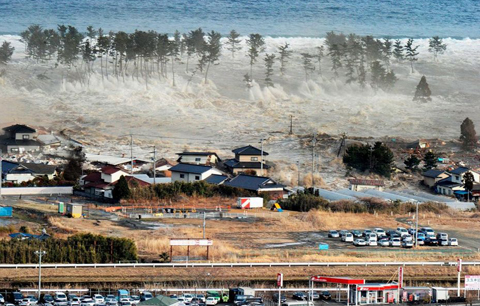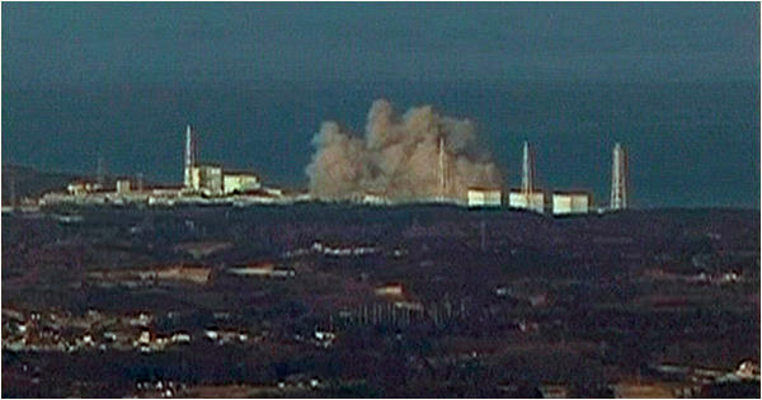No More Earthquakes and Tsunamis of 3/11
Just five years ago, a great earthquake occurred in the North Pacific Ocean 100 km or so off the Tohoku coast lines of Japan, specifically a 800 km-long coastal area north of Tokyo.
The magnitude M9.0 earthquake triggered a great tsunami, around 3 PM on March 11, 2011, that devastated the coastal cities, towns and villages as well as the Fukushima Daiichi nuclear power plant. About 18,000 Japanese were killed and hundreds of thousands of residents were forced to evacuate. Even today, tens of thousands of people are still living in temporary emergency residents.

http://blogs.itmedia.co.jp/techneco/220111231133216203.jpg
2011 Tōhoku earthquake and tsunami
The 2011 earthquake off the Pacific coast of Tōhoku was a magnitude 9.0 (Mw) undersea megathrust earthquake off the coast of Japan that occurred at 14:46 JST (05:46 UTC) on Friday 11 March 2011,[2][3][8] with the epicentre approximately 70 kilometres (43 mi) east of the Oshika Peninsula of Tōhoku and the hypocenter at an underwater depth of approximately 30 km (19 mi).
The degree and extent of damage caused by the earthquake and resulting tsunami were enormous, with most of the damage being caused by the tsunami. Video footage of the towns that were worst affected shows little more than piles of rubble, with almost no parts of any structures left standing.[219] Estimates of the cost of the damage range well into the tens of billions of US dollars; before-and-after satellite photographs of devastated regions show immense damage to many regions.[220][221] Although Japan has invested the equivalent of billions of dollars on anti-tsunami seawalls which line at least 40% of its 34,751 km (21,593 mi) coastline and stand up to 12 m (39 ft) high, the tsunami simply washed over the top of some seawalls, collapsing some in the process.
Japan's National Police Agency said on 3 April 2011, that 45,700 buildings were destroyed and 144,300 were damaged by the quake and tsunami. The damaged buildings included 29,500 structures in Miyagi Prefecture, 12,500 in Iwate Prefecture and 2,400 in Fukushima Prefecture.[223] Three hundred hospitals with 20 beds or more in Tōhoku were damaged by the disaster, with 11 being completely destroyed.[224] The earthquake and tsunami created an estimated 24–25 million tons of rubble and debris in Japan.[225][226]
An estimated 230,000 automobiles and trucks were damaged or destroyed in the disaster. As of the end of May 2011, residents of Iwate, Miyagi, and Fukushima prefectures had requested deregistration of 15,000 vehicles, meaning that the owners of those vehicles were writing them off as unrepairable or unsalvageable.



https://en.wikipedia.org/wiki/2011_T%C5%8Dhoku_earthquake_and_tsunami#JapanSince the end of WWII, Japan has not been engaged in any wars unlike the US, China, the UK, France, Russia, etc. It has never lost 18,000 or so human lives in a one-day incident, though the 1995 Hanshin-Kobe Earthquake took 6,000 lives. This is the largest incident after WWII for Japan.
What surprised the Japanese people in the wake of this great natural disaster, there was a historical record about a similar earthquake and tsunami of the similar scale. According to a history book written under authority of the imperial court in Kyoto in 901, the Pacific cost of the Tohoku region, namely almost the same area that suffered the 2011 Earthquake/Tsunami, was hit by a great earthquake and a subsequent tsunami in 869. Boring surveys conducted in the area after the 2011 natural disaster proved that it was a fact. So, the media started to call it a "disaster that could happen once in 1000 years." So, some people claimed: who could predict it? Or, as it seems to have a 1000 year cycle in occurrence, should the Japanese people have prepared for it as it could happen at any time since more than 1100 years had passed already?.
As for Fukushima Prefecture where the Fukushima Daiichi Nuclear Power Plant is situated, total about 1800 people were killed directly by the earthquake/tsunami among 2 million population. However the number of the deaths due to causes related to the earthquake/tsunami and the subsequent nuclear accident is more than 2000. They include old patients who were hospitalized in hospitals near the Fukushima Daiichi Nuclear Power Plant but could not evacuate in a safe and careful manner. They also include ole people who died in poor environment of temporary homes or under heavy stress caused by the disaster. What is worse, the number of yearly suicide cases in Fukushima Prefecture has doubled after the 2011 disaster in comparison with data before (namely 10 to more than 20).
There are still about 80,000 evacuees in Fukushima Prefecture due to the nuclear accident. To compensate for their damage, pains and inconvenience, Tokyo Electric Power Co., the owner of the nuclear power plant, is paying monthly 100,000 yen (about $900) for every evacuee, including babies. The utility is said to have already paid compensations of 1 trillion 800 billion yen (about $17 billion).

Hydrogen explosion of Unit No.1 of Fukushima Daiichi Nuclear Power Plant after the tsunami
http://news.softpedia.com/news/Earthquake-Damages-Japanese-Nuclear-Reactors-189294.shtml
(to be continued)
**** **** ****
Luk 3:10 And the people asked him, saying, What shall we do then?
Luk 3:11 He answereth and saith unto them, He that hath two coats, let him impart to him that hath none; and he that hath meat, let him do likewise.
